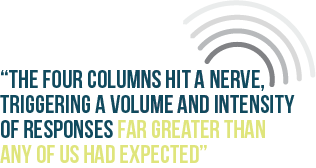
Our Story
 From columns to a monograph to a book to an initiative...
From columns to a monograph to a book to an initiative... 
In 2010, years of pent-up frustration boiled over. Philanthropist Mario Morino published a series of four columns (here, here, here, and here) about his growing anxiety that the social sector was doing far too little to encourage organizations to develop high-performance cultures capable of producing meaningful, measurable impact.
The columns hit a nerve, triggering a volume and intensity of responses far greater than any of us had expected.
His columns resonated with nonprofit leaders whose funders demand more information on results without paying attention to what grantees actually need in order to produce those results.
The columns resonated equally with funders who have had it with nonprofits that have no means whatsoever for determining whether they’re actually doing what they say they do for those they serve.
And that was the beginning of our Leap of Reason journey.
Venture Philanthropy Partners CEO Carol Thompson Cole encouraged Mario to turn the columns into a brief monograph. She saw that Mario’s perspectives, which were based not just on his 20 years in the nonprofit sector but also his decades of work helping Global 500 companies manage their IT resources for improved outcomes, had value for VPP’s stakeholders. She thought that a monograph might allow Mario and VPP to reach a broader audience.
Mario took up Carol’s charge. He reached out to VPP’s longtime strategic partner McKinsey & Company as well as six nonprofit experts and practitioners with front-line perspectives and asked them to contribute to the publication. The monograph morphed into a book with a wider set of perspectives.
In May 2011, Venture Philanthropy Partners published Leap of Reason: Managing to Outcomes in an Era of Scarcity. Mario cautiously hoped that a few thousand leaders would find the little chartreuse book (one colleague quipped that it’s the color of “radioactive broccoli”) to be of practical value for their work.
As of October 2013, the book is in the hands of more than 66,000 leaders. Now in its fourth printing, the book is informing board retreats, strategic-planning efforts, staff-development initiatives, and university management classes across the U.S. and in more than two dozen countries around the world. According to the National Council of Nonprofits, “the book has hit a home run in the nonprofit community.”
Based on the broad interest in the book, the Morino Institute has been at work ever since to expand upon the book’s key themes and spread them well beyond “the choir.” Our goal is to trigger a rethink about what it takes to produce great results for children, families, and communities—and what that requires of nonprofit leaders, agency heads, and funders of all types. To that end, the Leap of Reason Initiative is engaging in a wide array of movement-building activities—from writing to speaking to community-building efforts—in the hope of raising the bar on performance and doing much more to help nonprofits and public-sector agencies leap over that bar. For example, we published and promoted David Hunter’s book Working Hard—and Working Well, based on his transformative Theory of Change workshops, to provide practical insights for human services leaders who are ready to make the leap. We developed a series of learning packets tailored to boards, nonprofit executives, government agencies, and consultants/vendors serving nonprofits. And we have given numerous speeches (here’s a good example) to challenge courageous leaders to rethink, redesign, and reinvent for greater impact.
Our team is small, and the mind shift we’re trying to affect is not. But we believe that many nonprofit and public-sector leaders are gaining an appreciation by the day that business as usual is not a viable course. They are starting to feel the first shock-waves of major seismic shifts in our economy and society. They understand that they need to produce greater impact, at a lower cost, for those they serve. Our job is to help them and their funders see that the only realistic way to get there is by making the leap to high performance.








